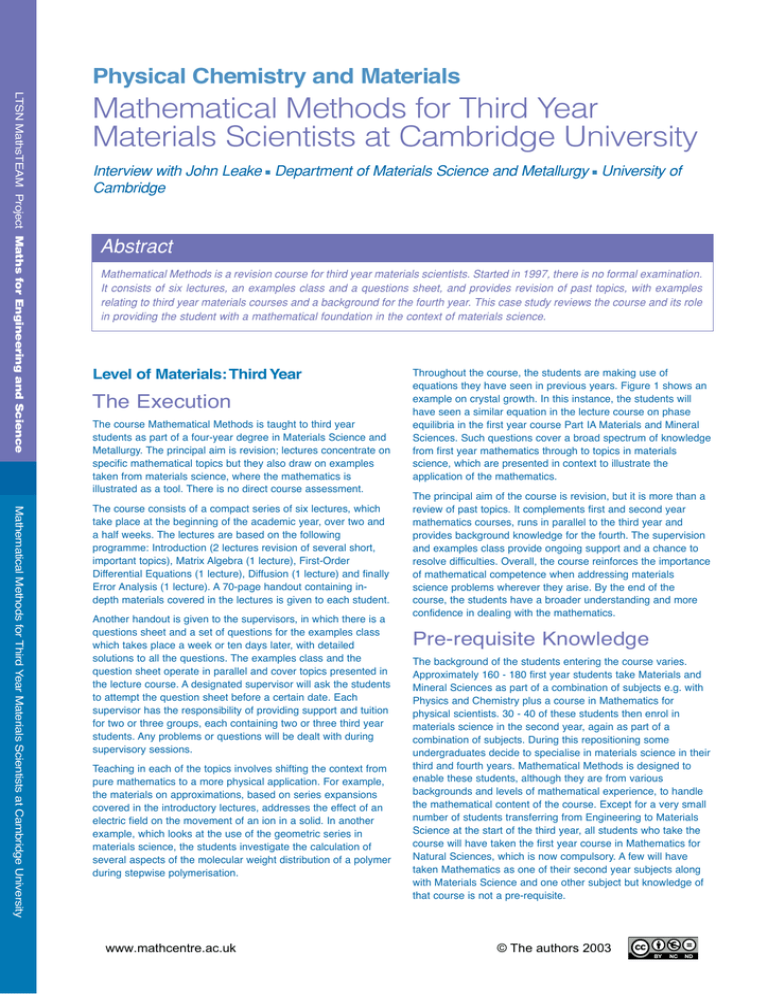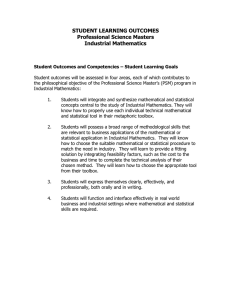Level of Materials: Third Year
advertisement

Physical Chemistry and Materials LTSN MathsTEAM Project Maths for Engineering and Science Mathematical Methods for Third Year Materials Scientists at Cambridge University Interview with John Leake ■ Department of Materials Science and Metallurgy ■ University of Cambridge Abstract Mathematical Methods is a revision course for third year materials scientists. Started in 1997, there is no formal examination. It consists of six lectures, an examples class and a questions sheet, and provides revision of past topics, with examples relating to third year materials courses and a background for the fourth year. This case study reviews the course and its role in providing the student with a mathematical foundation in the context of materials science. Level of Materials: Third Year The Execution The course Mathematical Methods is taught to third year students as part of a four-year degree in Materials Science and Metallurgy. The principal aim is revision; lectures concentrate on specific mathematical topics but they also draw on examples taken from materials science, where the mathematics is illustrated as a tool. There is no direct course assessment. Mathematical Methods for Third Year Materials Scientists at Cambridge University The course consists of a compact series of six lectures, which take place at the beginning of the academic year, over two and a half weeks. The lectures are based on the following programme: Introduction (2 lectures revision of several short, important topics), Matrix Algebra (1 lecture), First-Order Differential Equations (1 lecture), Diffusion (1 lecture) and finally Error Analysis (1 lecture). A 70-page handout containing indepth materials covered in the lectures is given to each student. Another handout is given to the supervisors, in which there is a questions sheet and a set of questions for the examples class which takes place a week or ten days later, with detailed solutions to all the questions. The examples class and the question sheet operate in parallel and cover topics presented in the lecture course. A designated supervisor will ask the students to attempt the question sheet before a certain date. Each supervisor has the responsibility of providing support and tuition for two or three groups, each containing two or three third year students. Any problems or questions will be dealt with during supervisory sessions. Teaching in each of the topics involves shifting the context from pure mathematics to a more physical application. For example, the materials on approximations, based on series expansions covered in the introductory lectures, addresses the effect of an electric field on the movement of an ion in a solid. In another example, which looks at the use of the geometric series in materials science, the students investigate the calculation of several aspects of the molecular weight distribution of a polymer during stepwise polymerisation. www.mathcentre.ac.uk Throughout the course, the students are making use of equations they have seen in previous years. Figure 1 shows an example on crystal growth. In this instance, the students will have seen a similar equation in the lecture course on phase equilibria in the first year course Part IA Materials and Mineral Sciences. Such questions cover a broad spectrum of knowledge from first year mathematics through to topics in materials science, which are presented in context to illustrate the application of the mathematics. The principal aim of the course is revision, but it is more than a review of past topics. It complements first and second year mathematics courses, runs in parallel to the third year and provides background knowledge for the fourth. The supervision and examples class provide ongoing support and a chance to resolve difficulties. Overall, the course reinforces the importance of mathematical competence when addressing materials science problems wherever they arise. By the end of the course, the students have a broader understanding and more confidence in dealing with the mathematics. Pre-requisite Knowledge The background of the students entering the course varies. Approximately 160 - 180 first year students take Materials and Mineral Sciences as part of a combination of subjects e.g. with Physics and Chemistry plus a course in Mathematics for physical scientists. 30 - 40 of these students then enrol in materials science in the second year, again as part of a combination of subjects. During this repositioning some undergraduates decide to specialise in materials science in their third and fourth years. Mathematical Methods is designed to enable these students, although they are from various backgrounds and levels of mathematical experience, to handle the mathematical content of the course. Except for a very small number of students transferring from Engineering to Materials Science at the start of the third year, all students who take the course will have taken the first year course in Mathematics for Natural Sciences, which is now compulsory. A few will have taken Mathematics as one of their second year subjects along with Materials Science and one other subject but knowledge of that course is not a pre-requisite. © The authors 2003 What Support Was Needed? Evidence of Success There is no direct measurement of the student’s achievement in the course. There is an indirect measurement in terms of the performance in other courses. In third and fourth year courses the students are expected to handle appropriate mathematical calculations in the examination. Although it has not been formally measured there is a clear indication that competence levels have improved. The ability to cope with mathematical components in lectures, practicals and projects across the courses during the third and fourth year has also shown signs of improvement. Supervisors have noticed that whilst the maths may be a challenge students are better able to cope. All told, there is enhanced performance and a willingness to handle the mathematical problems. The first step is to identify the courses where the maths is essential, in this instance materials science. Key mathematical topics must also be identified in the respective undergraduate courses. Once identified these topics will be covered in the lectures, the question sheet and the examples class in a way that makes direct application to the subject apparent. It is important to illustrate to the student that the topics covered are directly applicable to the subject. For those institutions that do not have a supervisory system in place extra example classes would be required. Quality Assurance All courses have standard format questionnaires, filled in by the students, and these are circulated to the Teaching Committee. The committee also provides the department with reports from the Internal and External Examiners highlighting particular features of the examination. Comments on a particular maths topic, which students are finding a problem, are fed back for those co-ordinating the course to consider. In addition, there are consultative meetings at the end of the main terms with representatives from each of the undergraduate years. Frequent contact with the supervisors, including informal contact in the departmental Common Room, provides a valuable source of comments based on individual student progress. Mathematical Methods for Third Year Materials Scientists at Cambridge University Figure 1: Crystal Growth Model www.mathcentre.ac.uk LTSN MathsTEAM Project Maths for Engineering and Science The team of supervisors provides ongoing support for the students. Problems are addressed as the students work through the question sheet and the examples class questions. At the end of the term, the supervisors produce a report commenting on individual students’ progress. These are placed online. Each student can access his/her own reports, as can their designated academic advisors (Tutor and Director of Studies). How Can Other Academics Reproduce This? © The authors 2003





